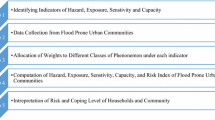Abstract
Community-based flood risk assessment has gained increasing attention as communities are the first responder to disasters and thus the key player of disaster risk reduction. In this study, using a scenario-based risk model and the combination of 1D/2D hydrodynamic model and participatory geographic information system, a methodology for flood risk assessment at the community level is put forward, including flood hazard assessment, exposure analysis, vulnerability assessment, and loss estimation and risk profiling. With this methodology, a set of potential damage/loss scenarios with various probabilities of flood occurrence can be established, and the spatial distribution of the loss in different probabilities can be mapped as well. It is proved that the proposed methodology is effective in flood risk assessment at the community level. The case study of Taining county town shows that the threats and impacts of flood disaster on the community are significant, and it is necessary to take structural and non-structural measures to reduce the flood risk.











Similar content being viewed by others
References
Apel H, Aronica G, Kreibich H et al (2009) Flood risk analyses—how detailed do we need to be? Nat Hazards 49:79–98
Arnell N (1989) Expected annual damages and uncertainties in flood frequency estimation. J Water Resour Plan Manag 115:94–107
Arrighi C, Brugioni M, Castelli F et al (2013) Urban micro-scale flood risk estimation with parsimonious hydraulic modelling and census data. Nat Hazards Earth Syst Sci 13:1375–1391
De Moel H, Jongman B, Kreibich H et al (2015) Flood risk assessments at different spatial scales. Mitig Adapt Strat Glob Change 20:1–26
Dyck J, Willems P (2013) Probabilistic flood risk assessment over large geographical regions. Water Resour Res 49:3330–3344
Gilles D, Young N, Schroeder H et al (2012) Inundation mapping initiatives of the Iowa Flood Center: statewide coverage and detailed urban flooding analysis. Water 4:85–106
Hall J, Dawson R, Sayers P et al (2003) A methodology for national-scale flood risk assessment. Proc ICE-Water Marit Eng 156:235–247
Harvey G, Thorne C, Cheng X et al (2009) Qualitative analysis of future flood risk in the Taihu Basin, China. J Flood Risk Manag 2:85–100
Huang F (2012) Flood disaster situation and cause analysis in Taining county, Fujian province in 2010. China Flood Drought Manag 22:58–61 (in Chinese)
IPCC (2012) Managing the risks of extreme events and disasters to advance climate change adaptation. A special report of working groups I and II of the intergovernmental panel on climate change. Cambridge University Press, Cambridge, pp 1–594
Kaplan S, Garrick B (1981) On the quantitative definition of risk. Risk Anal 1:11–27
Merz B, Thieken A, Gocht M (2007) Flood risk mapping at the local scale: concepts and challenges. Flood risk management in Europe. Springer, Netherlands, pp 231–251
Merz B, Kreibich H, Schwarze R et al (2010) Review article “Assessment of economic flood damage”. Nat Hazards Earth Syst Sci 10:1697–1724
Peters-Guarín G, van Westen C, Montoya L (2005) Community-based Flood Risk Assessment using GIS for the Town of San Sebastian, Guatemala. J Hum Secur Dev 1:29–49
Petrow T, Thieken A, Kreibich H et al (2006) Improvements on flood alleviation in Germany: lessons learned from the Elbe flood in August 2002. Environ Manage 38:717–732
Rambaldi G, Kyem P, McCall M et al (2006) Participatory spatial information management and communication in developing countries. Electron J Inf Syst Dev Ctries 25:1–9
Smith D (1994) Flood damage estimation—a review of urban stage-damage curves and loss functions. Water SA 20:231–238
Tran P, Shaw R, Chantry G et al (2009) GIS and local knowledge in disaster management: a case study of flood risk mapping in Viet Nam. Disasters 33:152–169
UNISDR (2005) Hyogo framework for action 2005–2015: building the resilience of nations and communities to disasters. In: World conference on disaster reduction, Kobe, Hyogo, Japan
UNISDR (2015) Sendai framework for disaster risk reduction 2015–2030. In: Third world conference on disaster risk reduction (3WCDRR), Sendai, Japan
Wang Y, Li Z, Tang Z et al (2011) A GIS-based spatial multi-criteria approach for flood risk assessment in the Dongting Lake Region, Hunan, Central China. Water Resour Manage 25:3465–3484
White I, Kingston R, Barker A (2010) Participatory geographic information systems and public engagement within flood risk management. J Flood risk Manag 3:337–346
Wind H, Nierop T, Blois C et al (1999) Analysis of flood damages from the 1993 and 1995 Meuse floods. Water Resour Res 35:3459–3465
Winsemius H, Van Beek L, Jongman B et al (2013) A framework for global river flood risk assessments. Hydrol Earth Syst Sci 17:1871–1892
Yin J, Yu D, Yin Z et al (2013) Multiple scenario analyses of Huangpu River flooding using a 1D/2D coupled flood inundation model. Nat Hazards 66:577–589
Zhao Q, Wang J, Xu S et al (2010) Flood risk assessment of coastal community: a case study in Longwan District of Wenzhou City. Geogr Res 29:665–674 (in Chinese)
Zhu J (2010) Urban flash-flood risk assessment: a case study in Wenshan City, Yunnan. Geogr Res 29:655–664 (in Chinese)
Author information
Authors and Affiliations
Corresponding author
Rights and permissions
About this article
Cite this article
Li, W., Xu, B. & Wen, J. Scenario-based community flood risk assessment: a case study of Taining county town, Fujian province, China. Nat Hazards 82, 193–208 (2016). https://doi.org/10.1007/s11069-016-2187-2
Received:
Accepted:
Published:
Issue Date:
DOI: https://doi.org/10.1007/s11069-016-2187-2




